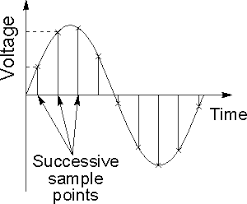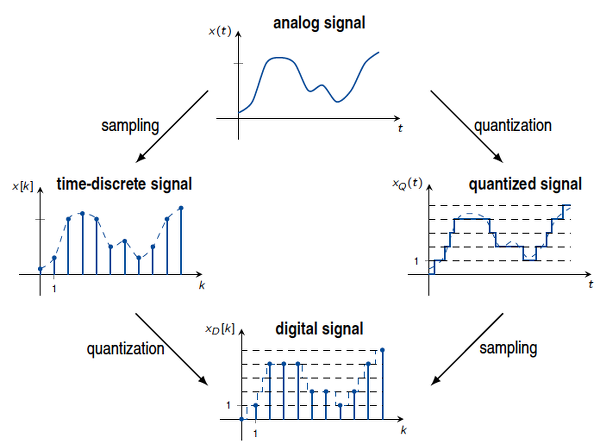Difference between the Analog signals and Digital signals
| Analog signals | Digital signals |
|---|---|
| Analog signals are difficult to get analysed at first. | Digital signals are easy to analyse. |
| Analog signals are more accurate than digital signals. | Digital signals are less accurate. |
| Analog signals take time to be stored. It has infinite memory. | Digital signals can be easily stored. |
| To record an analog signal, the technique used, preserves the original signals. | In recording digital signal, the sample signals are taken and preserved. |
| There is a continuous representation of signals in analog signals. | There is a discontinuous representation of signals in digital signals. |
| Analog signals produce too much noise. | Digital signals do not produce noise. |
| Examples of analog signals are Human voice, Thermometer, Analog phones etc. | Examples of digital signals are Computers, Digital Phones, Digital pens, etc. |
Conversion of Analog signals to Digital signals
Most of the image sensors are in the analog signal, and digital processing cannot be applied on it, as it requires infinite memory to store because signals have an infinite value that is why we cannot store it.
To create a digital image we can convert data into digital form.
For the conversion there are two steps:
- Sampling
- Quantization
To convert an analog signal into a digital signal, both its axis(x,y) are converted into digital format.

As we can see that image is continuous in its coordinates(x-y). So sampling deals with digitizing of co-ordinates and quantization deals with digitizing the amplitude.
Sampling
In analog signals, there are continuous electrical signals that vary with time. With the help of subsystem, a sampler extracts continuous signals for the sampling of signals.

(Sampling of signals)
Sampling is done along the x-axis of signals that continuously differs with time. It is divided into two category one is sampling and other is downsampling.
In downsampling, the range of values on the x-axis is always less.
Quantization
It is a process of image processing, in which continuous and time-varying values of analog signals are divided into non-overlapping discrete and unique values assigned to each subrange.
Sampling and quantization are opposite to each other. Sampling is done along the x-axis but quantization is done along the y-axis.
In the image processing, the sampled image is considered as a digital value. When there is a transition of states between time-varying values of image function and its digital equivalent signifies quantization.

(conversion of analog signals to digital signals).
The main problem in the image is the continuous occurrence of false contours which can be quantized later with inadequate brightness levels. The fine shading of the image depends on the level of quantization.
